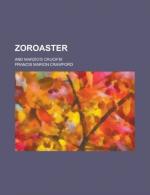At first, he was dazzled for a moment, but his memory served him instantly and he recognised the face and form of a woman he had known and often seen before. She was not tall, but so perfectly proportioned that it was impossible to wish that she were taller. Her close tunic of palest blue, bordered with a gold embroidery at the neck, betrayed the matchless symmetry of her figure, the unspeakable grace of development of a woman in the fullest bloom of beauty. From her knees to her feet, her under tunic showed the purple and white bands that none but the king might wear, and which even for the queen was an undue assumption of the royal insignia. But Zoroaster did not look at her dress, nor at her mantle of royal sea-purple, nor at the marvellous white hands that held together a written scroll. His eyes rested on her face, and he stood still where he was.
He knew those straight and perfect features, not large nor heavy, but of such rare mould and faultless type as man has not seen since, neither will see. The perfect curve of the fresh mouth; the white forward chin with its sunk depression in the midst, the deep-set, blue eyes and the straight pencilled brows; the broad smooth forehead and the tiny ear half hidden in the glory of sun-golden hair; the milk-white skin just tinged with the faint rose-light that never changed or reddened in heat or cold, in anger or in joy—he knew them all; the features of royal Cyrus made soft and womanly in substance, but unchanging still and faultlessly cold in his great daughter Atossa, the child of kings, the wife of kings, the mother of kings.
The heavy curtains had fallen together behind her, and she came forward alone. She had seen Zoroaster before he had seen her, and she moved on without showing any surprise, the heels of her small golden shoes clicking sharply on the polished floor. Zoroaster remained standing for a moment, and then, removing his helmet in salutation, went to one side of the head of the staircase and waited respectfully for the queen to pass. As she came on, passing alternately through the shadow cast by the columns, and the sunlight that blazed between, her advancing figure flashed with a new illumination at every step. She made as though she were going straight on, but as she passed over the threshold to the staircase, she suddenly stopped and turned half round, and looked straight at Zoroaster.
“Thou art Zoroaster,” she said in a smooth and musical voice, like the ripple of a clear stream flowing through summer meadows.
“I am Zoroaster, thy servant,” he answered, bowing his head. He spoke very coldly.
“I remember thee well,” said the queen, lingering by the head of the staircase. “Thou art little changed, saving that thou art stronger, I should think, and more of a soldier than formerly.”
Zoroaster stood turning his polished helmet in his hands, but he answered nothing; he cared little for the queen’s praises. But she, it seemed, was desirous of pleasing him in proportion as he was less anxious to be pleased, for she turned again and walked forward upon the terrace.




